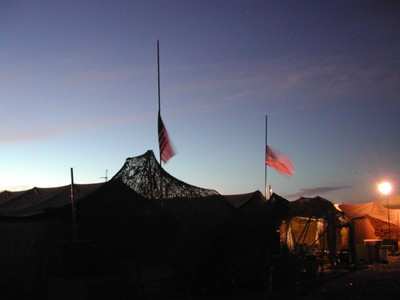US Spent Fortune Improving Abandoned Base
by Aero-News Senior Correspondent Kevin R.C. "Hognose"
O'Brien
The US Base at Karshi-Khanabad is no more. The base where I
spent way too much time at a Special Forces FOB in 2002-03 is now
back in Uzbek hands after a ceremony on Monday, November 21, 2005,
in which the last US commander handed over a set of symbolic keys,
and the US flag was struck down and folded. (The Uzbekistan flag
already flew over "their" section of the base; the US camp was
all-new and was built in what had been an open mud field, and still
was when it rained).
Later this week, the Uzbek government followed up by NATO
(mostly German) forces out of their Uzbek base, at Termez on the
Oxus River (Amu Darya) which defines the Uzbekistan-Afghanistan
border.
The Uzbek government of Soviet-era president Islam Karimov (last
election, 99% point something) had ordered the US out by year's end
after the US criticized the Uzbek response to anti-government riots
last spring, which included both pro-democracy and pro-Islamist
elements. The government reacted to the riots by gunning down
hundreds of protesters, sparking harsh criticism from the US.
European powers were more muted in their criticism, but NATO
suspended a cooperation agreement last month, and the European
Union recently forbade 12 specific Uzbek officers from entering the
EU; the 12 officers were reportedly involved in the spring
crackdown.
Khanabad Air Base near the Silk Road city of Karshi, long home
to the Uzbekistan Air Force's strike force of Su-27s, Su-27s and
Mi-29s, was an important command post and logistics base early in
the war in Afghanistan. US Forces knew it as Karshi-Khanabad or
"K2." Originally, it was arranged for one SF FOB and four USAF
special operations airplanes, MC- and AC-130s.
The MC-130 crews were highly prized by the Army special
operators because they would not be deterred from landing by a few
ineptly filled bomb craters on a runway, or a little gunfire around
the periphery of the airfield. The "slick" C-130 crews might well
have been equally fearless, but they operated under more
restrictive regulations, that made them pass more hazardous areas
by.
Later, the special ops C-130s were joined by Air Rescue HH-60s
and their aircrews and pararescue jumpers.
But over the years, the base grew, and became much more involved
in entertaining and feeding its own staff, which peaked as a
micro-city of well over 5,000 logistical troops. In the current GI
slang, it had become a "self-licking ice cream cone" all but
inconsequential to the war.
Long before the riots of April 2005 started the chain reaction
which led to this week's furling of the US flag, the special
operators had withdrawn. By then, apart from fresh foods which came
from Europe and were shipped overland by truck to Kandhar and
Bagram in Afghanistan, the only contribution the base made to the
Coalition effort in Afghanistan was as a trans-shipment point for
humanitarian aid.

A great deal of money was spent, both renting it from the
Uzbeks, and improving the facilities. After the SOF troops were
joined by support elements, several headquarters buildings were
built, each larger and grander than the last.
Many American veterans will remember K2 for its mud, its dust,
and its environmental health hazards. The SF FOB gratefully moved
from a hardened aircraft shelter into a sturdy plywood building
hastily assembled by a Reserve construction unit, after the HAS was
discovered to have hazardous levels of ionizing radiation (this
base was once the home of Soviet nuclear bombers). A USAF combat
rescue unit remained in a HAS, as theirs didn't peg the Geiger
counter. Other hazards on the former Soviet air base included
unexploded ordnance, a chemical minefield to which the map had been
lost, and most toxic chemicals known to science.
The cash-strapped Uzbekistan Air Force seldom flew its MiG and
Sukhoi airplanes, and then when it did, it only flew the two-seat
variants. An Uzbek officer explained that this was to get the
maximum pilot training benefit out of each mission.
Originally, the base poured vast quantities of money into the
local area, by employing an army of locals almost equal to the
number of US troops, by using local contractors to construct many
millions of dollars worth of buildings, roads and other works, and
by the free-spending of GIs in the nearby city of Karshi, which
offered restaurants, night clubs, and sightseeing.
Over the winter of 2002-03 the troops were restricted to base, a
restriction which remained in place till US withdrawal.
Sufficient alternatives to the air base exist that there will be
no real disruption to the US effort in Afghanistan; the same is
true of the NATO base at Termez. Indeed, NATO is considering
relocating its logistics hub inside Afghanistan, to the north
central city of Mazar-e Sharif. The Uzbek cold shoulder extends
even to overflights for humanitarian aid, an imposition that both
US and NATO forces have said will not delay or disrupt the flow of
assistance to the recovering nation.
Image Credits: The three pictures with this
report were taken by Hognose in 2002 and 2003 at this base. The
overhead image is from 2001, courtesy SpaceImaging.com (the US area
is on the left). To see more of K2, this link leads
to a US Air Force photo essay on K2, taken in late January,
2005.
 Airborne 05.10.24: Icon Auction, Drunk MedEvac Pilot, Bell ALFA
Airborne 05.10.24: Icon Auction, Drunk MedEvac Pilot, Bell ALFA ANN's Daily Aero-Term (05.13.24): ILS PRM Approach
ANN's Daily Aero-Term (05.13.24): ILS PRM Approach ANN's Daily Aero-Linx (05.13.24)
ANN's Daily Aero-Linx (05.13.24) Airborne-NextGen 05.07.24: AI-Piloted F-16, AgEagle, 1st 2 WorldView Sats
Airborne-NextGen 05.07.24: AI-Piloted F-16, AgEagle, 1st 2 WorldView Sats Airborne 05.08.24: Denali Update, Dad-Daughter Gyro, Lake SAIB
Airborne 05.08.24: Denali Update, Dad-Daughter Gyro, Lake SAIB



